The Love Triangle Spread

Difficulty: Complicated
Casually referred to as the Love Triangle, this spread can be used to determine the dynamics of the relationship between three people, regardless of whether romance is involved. This spread is arranged in the form of a hexagram, consisting of several large and small triangles. This tarot spread may seem somewhat complicated, but it is not entirely that difficult.
The first step is to interpret the card for each individual position in the spread. Generally, one might ask about a relationship they are involved in, but this does not have to be the case. Ordinarily, the reader's representative card is #1, their main person of interest is #2, and the other person would be #3.
The second step fills in the downward triangle and involves further examination of the individuals through their views of the other people. Each person has two more cards showing the way they see and relate to the other members of the triangle. For example, Card #6 indicates how Person #3 relates to Person #1, while Card #9 stands for Person #1's attitude toward Person #3.
The next step completes the upward triangle and the hexagram, focusing on cards #10–13. It also completes the many smaller triangles and hints at the potential for each relationship. The final card, #13 can be considered the significator of the reading, which suggests the overall potential for this three-way relationship.
Your Love Triangle Reading
| P#3 | 3to2 | 2+3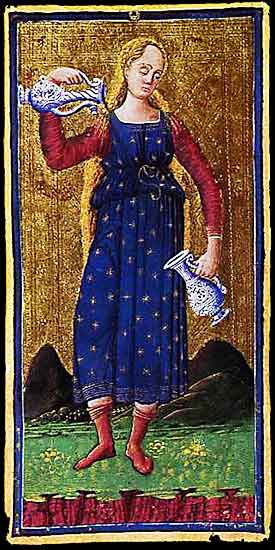 |
2to3 | P#2 | ||
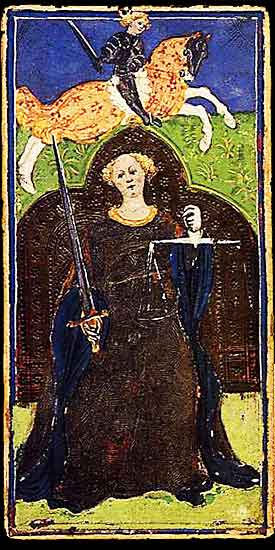 |
3to1 | 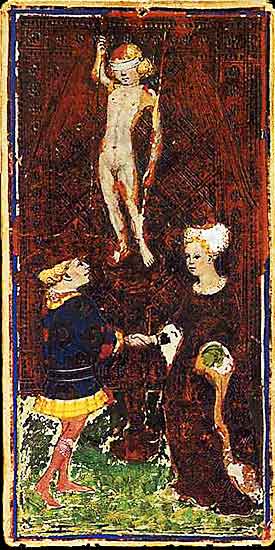 |
Overall | 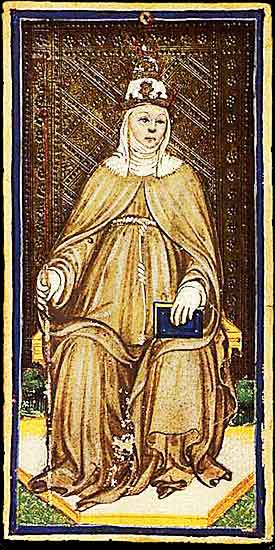 |
2to1 | 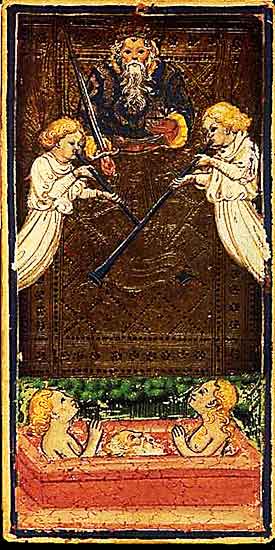 |
| 1+3 | 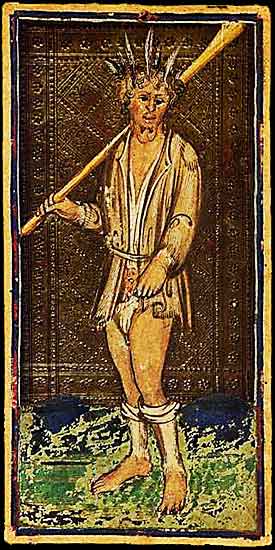 |
1to3 | 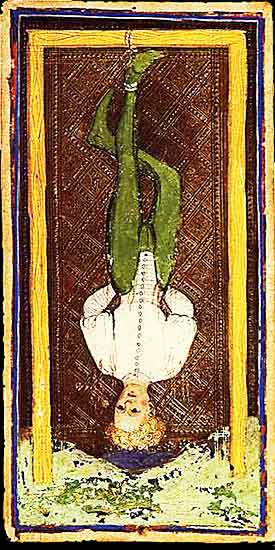 |
1to2 |  |
1+2 |
 |
 |
P#1 |  |
 |
||
 |
1: Person #1

The Wheel of Fortune signifies cycles, fate, and the ever-changing nature of life. It reminds us of the importance of adaptability and acceptance in the face of change.
Symbolism: Figures ascending and descending on the wheel represent the ups and downs of life. The patterns add richness to the composition, while the golden background underscores the divine and inevitable nature of change.
In Relationships: A turning point in relationships, whether for better or worse. The Wheel reminds us to embrace change.
In Work: Unexpected opportunities or setbacks. It advises adaptability and resilience in navigating shifting circumstances.
Spiritually: The Wheel teaches surrender to the cycles of life and faith in the greater plan of the universe.
When ill-dignified: Resistance to change, bad luck, or repeating cycles. It warns against clinging to the past or fearing the future.
2: Person #2

Judgement is the call for awakening, renewal, and reckoning. It signals a time of reckoning with the past, a moment of judgement that clears the way for a fresh start and new direction.
Symbolism: The angel blowing the trumpet signals a divine call to action, summoning figures from their tombs to rise and transform. The symmetrical composition emphasises the balance between life and death, while the golden glow underscores the sacred nature of the awakening. The figures' age gap represents a new life, renewed through divine grace.
In Relationships: Judgement invites you to release past hurts and transform your relationships. It calls for honesty, introspection, and a fresh start in emotional matters.
In Work: A moment of reckoning, where past actions may come to light. This card suggests an opportunity for reinvention, a chance to leave behind outdated modes of working and embrace new ways.
Spiritually: Judgement calls for spiritual awakening and enlightenment. It asks you to evaluate your choices and rise to your higher calling.
When ill-dignified: Denial, resistance to transformation, or an inability to face the truth. This may indicate emotional or spiritual stagnation, or the refusal to heed the call of renewal.
3: Person #3

Justice represents fairness, balance, and accountability. It signifies the importance of truth and the consequences of one's actions, urging you to act with integrity.
Symbolism: The seated figure holds a sword and scales, embodying fairness and the enforcement of law. The richly adorned gown and golden background highlight the divine and universal nature of justice, while the knight in the background underscores executive authority.
In Relationships: A need for honesty and balance. Justice may signal the resolution of conflicts or the importance of mutual respect.
In Work: Fair rewards for effort and accountability for mistakes. Justice encourages acting with integrity and taking responsibility.
Spiritually: Justice emphasises the law of karma and the importance of living a life aligned with truth and fairness.
When ill-dignified: Bias, dishonesty, or imbalance. It warns against unfair judgements or evading accountability.
4: Person #1's view of #2

The Pope represents tradition, spiritual authority, and shared values. He embodies the connection between divine wisdom and earthly institutions, urging adherence to established principles.
Symbolism: The Pope's raised hand conveys blessing, while his staff with a triple cross represents divine authority. The kneeling figures at his feet highlight devotion and the transmission of sacred teachings. The symmetrical composition and golden background reinforce his role as a stabilising spiritual guide.
In Relationships: A union founded on shared values or traditions. It may suggest the influence of societal expectations on relationships.
In Work: Success comes through adherence to established systems or mentorship from a trusted authority figure.
Spiritually: The Pope urges respect for spiritual traditions and the wisdom passed down through generations.
When ill-dignified: Dogma, blind conformity, or resistance to innovation. It cautions against rigid adherence to outdated ideas.
5: Person #2's view of #3

The Popess signifies intuition, mystery, and hidden wisdom. She represents the need to look inward and trust one's inner voice while respecting the unknown and unseen.
Symbolism: Her veil and book symbolise the sacred mysteries she guards. The golden background elevates her presence, while her fancy robes reflect the complexity of her spiritual knowledge. Her composed demeanour conveys her role as a keeper of divine truths.
In Relationships: A time to trust your instincts. The Popess may suggest unspoken feelings or the need for patience.
In Work: Hidden opportunities or knowledge may come to light. Use intuition and discretion when making decisions.
Spiritually: A call to explore inner wisdom and the mysteries of life. Trust the subtle guidance of intuition.
When ill-dignified: Secrets, deception, or an overreliance on logic at the expense of intuition.
6: Person #3's view of #1

The Fool symbolises new beginnings, innocence, and an open-hearted journey. He represents the spirit of adventure and trust in the unknown, unburdened by experiences or material concerns. His path is one of discovery, where curiosity leads the way.
Symbolism: The vagabond's tattered clothing reflects detachment from societal norms, while his staff and bundle suggest minimal baggage—both physical and emotional. The golden background highlights his eternal and universal journey. His carefree, open-mouthed expression conveys both the naivety of youth and the wisdom of freedom from expectations.
In Relationships: A signal to take risks or approach relationships with spontaneity and trust. It cautions against naivety or reckless behaviour.
In Work: An invitation to embrace a new path or project with an open mind. The Fool encourages experimentation and trust in one's instincts.
Spiritually: The Fool represents faith in the journey ahead and the courage to step into the unknown. He invites the seeker to trust the divine flow.
When ill-dignified: Foolishness, poor judgement, or recklessness. It warns against ignoring practicalities or rushing ahead blindly.
7: Person #2's view of #1

The Hermit symbolises introspection, solitude, and the search for wisdom. He represents the retreat from worldly distractions to find enlightenment within.
Symbolism: The Hermit's lantern lights the way, symbolising inner guidance. His heavy robes and staff reflect humility and steadfastness, while the muted tones and golden accents emphasise the sacred nature of his solitary journey.
In Relationships: A period of introspection. The Hermit may suggest a need for space or reflection before moving forward.
In Work: Time to step back and assess your goals. The Hermit advises seeking clarity and wisdom before making decisions.
Spiritually: The Hermit represents the inner search for truth and enlightenment through meditation and solitude.
When ill-dignified: Isolation, withdrawal, or a refusal to seek help. It warns against becoming too introspective or disconnected.
8: Person #3's view of #2

The Lovers represent choice and the uniting of opposites. It embodies the transformative power of love and the necessity of making meaningful decisions.
Symbolism: The young couple standing beneath Cupid symbolises connection and divine guidance in love. The formal Renaissance clothing and the golden background elevate their union to a sacred level, while the static composition emphasises balance and deliberate choice.
In Relationships: A powerful connection that unites hearts and souls. It may signify a new relationship or a pivotal choice in love.
In Work: A partnership or decision with far-reaching consequences. The Lovers encourage the alignment of values with your work.
Spiritually: The Lovers symbolise unity with your higher self and the harmonious integration of opposites.
When ill-dignified: Temptation, discord, or indecision. It warns against superficial connections or poor choices.
9: Person #1's view of #3

The Empress symbolises abundance, creativity, and nurturing energy. She represents the generative force of nature and the ability to create and sustain growth, both literally and figuratively.
Symbolism: The Empress's sceptre and crown symbolise her authority, while her shield connects her to the Visconti family lineage. The floral embroidery on her gown reflects her connection to nature and fertility. The golden background underscores her divine and regal status.
In Relationships: A time of emotional abundance and nurturing. The Empress signals love, harmony, and growth.
In Work: Creative projects flourish under the Empress's guidance. She encourages nurturing ideas and building strong foundations.
Spiritually: The Empress represents the divine feminine, inviting the seeker to embrace growth and connect with nature's rhythms.
When ill-dignified: Stagnation, overindulgence, or a smothering presence in relationships.
10: Overall relationship between persons #1 and #2

The Magician embodies skill, potential, and the power to manifest. He represents the mastery of tools and resources, as well as the confidence to create one's reality. This card speaks of the importance of focus and action in shaping personal success.
Symbolism: The Magician's table holds simple tools, symbolising practical skills and raw materials. His Renaissance attire conveys refinement and expertise, while the golden background suggests his elevated role in shaping the material world. His seated position emphasises composure and control over his craft.
In Relationships: A call to use charm and communication to strengthen relationships. It warns of manipulation if ill-intentioned.
In Work: A time to take initiative and harness your abilities to achieve success. The Magician encourages innovation and confidence.
Spiritually: The Magician bridges the physical and spiritual, reminding the seeker to channel divine inspiration into practical actions.
When ill-dignified: Misuse of skills, deception, or scattered energy. It warns against overconfidence or manipulation.
11: Overall relationship between persons #2 and #3

Temperance represents harmony, balance, and the art of blending opposites. It suggests a time of calm, careful moderation, and the synthesis of differing energies into a cohesive whole.
Symbolism: Pouring liquid from one vessel to another symbolises the balance and exchange between opposing forces—emotion and intellect, fire and water, inner and outer worlds. Her graceful posture and tranquil demeanour indicate deliberate action, emphasising that peace comes through moderation. The golden background elevates balance to the divine level, suggesting that harmony is sacred.
In Relationships: Temperance encourages balance in relationships. It asks for patience and moderation in interactions, fostering an environment where both partners can harmonise their differences.
In Work: Success comes through collaboration and maintaining equilibrium. This card advises you to blend your talents with those of others, seeking compromise rather than extremes.
Spiritually: Temperance represents spiritual equilibrium. It calls for integrating the material and spiritual worlds, balancing one's desires and needs for peace and alignment.
When ill-dignified: Imbalance, excess, or a lack of harmony. This could indicate dissonance in relationships, career, or spiritual practice, warning against overindulgence or extremes.
12: Overall relationship between persons #1 and #3

Death signifies the inevitable conclusion of one cycle and the heralding of another. It's a powerful symbol of transformation, renewal, and the necessity of endings to foster new beginnings.
Symbolism: The skeletal figure with a scythe represents the impartial and unrelenting nature of time and change. The image of fallen bodies suggests the end of a phase, but the subtle floral designs interwoven with the scene offer hope, symbolising rebirth and the cyclical nature of existence. The golden background emphasises the universal truth of transformation and the inevitability of all life cycles.
In Relationships: This card suggests the end of an old emotional pattern or relationship, clearing the way for renewal. Let go of what no longer serves you to make space for new, healthier connections.
In Work: Death marks the close of one professional chapter. It's a time for endings, making way for new opportunities and growth. Embrace the transition instead of fearing it.
Spiritually: Death calls for a transformation, letting go of old beliefs or attachments. Spiritual rebirth requires an embrace of the unknown and a surrender to the cycles of existence.
When ill-dignified: Resistance to change, stagnation, and fear of letting go. This can manifest as clinging to the past or an inability to move forward, hindering growth.
13: Overall 3-way Relationship

The Hanged Man represents a moment of suspension, transformation, and the profound wisdom of surrender. It is the card of acceptance, urging one to release control and embrace a new perspective, even at the cost of discomfort.
Symbolism: The figure's suspended position signifies the state of hanging between worlds, a soul caught in the liminal space between the old and new. The calm expression of surrender contrasts with his precarious state, highlighting the necessity of letting go to gain understanding. The patterns of his tunic, combined with the golden glow, evoke a sacred pause in time, elevating this card to a spiritual level.
In Relationships: A time to step back and reassess your emotional life. Patience, understanding, and self-reflection are required. The card suggests moments of stillness can lead to profound growth in relationships.
In Work: Professional progress comes through rethinking old strategies. The Hanged Man indicates that a temporary pause or a shift in perspective can lead to breakthroughs.
Spiritually: The card speaks to spiritual enlightenment through sacrifice and release. You are called to surrender to the flow of life and gain higher wisdom.
When ill-dignified: Resistance to change, stagnation, and a refusal to let go. This warns against being trapped by fear or obstinance, preventing personal growth.